.
Post 45 -by Gautam Shah (Blog 15 in Lecture Series Space and Human Behaviour)
This is the Lecture 14 in series Space and Human Behaviour, which could not be loaded earlier at Blog DESIGN ACADEMICS ( https://designacademics.wordpress.com/ ).
.
Spaces need validation from time to time and on occasions. The validation by a user is continuous one, but as handled by a professional, is a contractual and periodical assignment. The change in space by a user, a lay person, relates to the rearrangements of the demountable and movable entities. A contractual assignment to a professional, however, is far more encompassing, and may even reconfigure the space shell. Domestic space planning is often self authored, whereas commercial spaces are rejuvenated by professionals.

NEED FOR SPACE PLANNING
Domestic spaces do not require frequent changes, usually for the first 15/20 years. Major alterations are required when ownership changes. The space planning or arrangements become invalid due to normal wear-tear, but also due to the user related circumstances, such as the changes in a family profile like age, physical abilities, marital status, professional interests, new intra-personal relationships and group dynamics, choices and social compatibility.

Commercial spaces see frequent changes both of the tenants and business styles. Space planning is also affected due to the user related causes such as: new concepts, aspirations, realizations, technology, variations in usage intensities, repairs and maintenance, optimum standards in society.
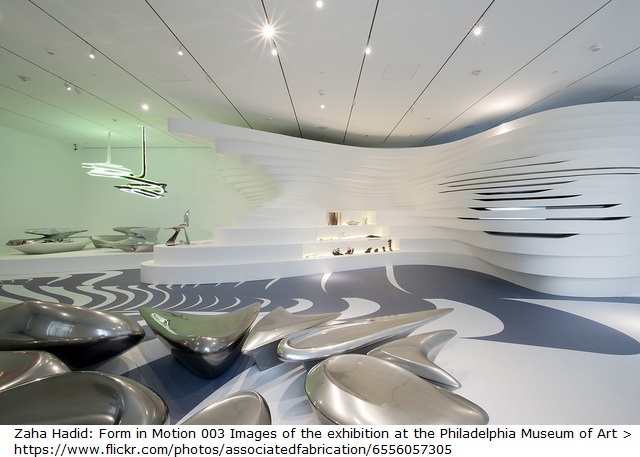
In all types of spaces planning needs a recast when changes in building shell or structure alters the spatial quality. New space planning is required when few key elements get a new look or functional replacement and refurbishment. Incorporation of new technologies (air conditioning, surveillance, security procedures, illumination, communication, information systems, storage systems), force new space planning. Space planning is hastened by major events like festivals, Olympics etc. Space planning reflects the access to expandable incomes available to person or national economy.
SPACE PLANNING DEVELOPMENTS
The space planning as space efficiency methods emerged in later part of the Industrial Revolution period (1800s). This was an age when number of gadgets for kitchens, toilets, craft areas, offices, industry, etc., began to be available. The gadgets were conceived both for free siting as well as fitments into a space, with planned connectivity and inter gadget relationships. Approach to ‘comprehensive planning’ later became ‘Systems Planning’. Women’s hobby magazines of the time took it further, and helped in creating work efficiency layouts (home productivity) with behavioural considerations. For example, a window over a cooking range and sink were a result of these attitudes. At industrial level the line production layouts were carefully planned and regularly updated. The ‘mega foot print’ or extensive spaces of commercial offices required major re-haul of layouts when illumination and heating-cooling were electrified, telephony and better document storage systems became common. The new departmental stores of 1950s required very frequent space re-planning because of the fast changing brands and their packing formats.
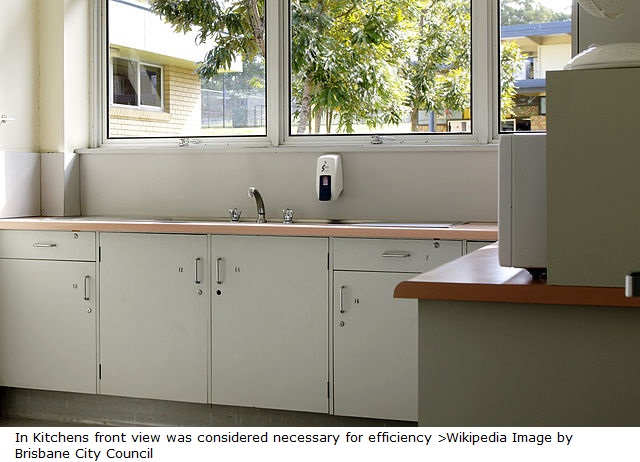
At domestic level the house, which had highly room specific spaces began to be open plan layouts with minimal of walls and partitions. It offered large unhindered spaces for various tasks. This was also due to the smaller or one person family. The gadgets that were bulky requiring structural bearing were now multi tasking, miniatures, mobile or easily relocatable and affordable. This freed lot of space and need for compulsive siting.
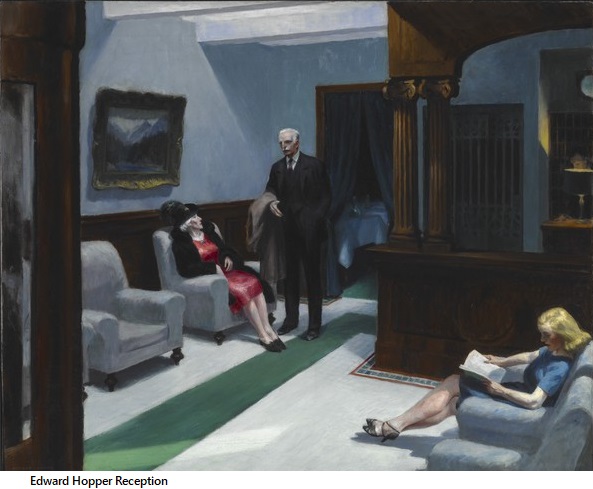
It was now clear that anthropometric data or ergonomics was not the only consideration, but behaviour of the human beings was the key consideration for space planning. The definition of spatial and occupancy requirements were important. Other thoughts related to flexibility of accommodating the future growth, access for the disabled, safety, security, etc. Homes, offices, industrial plants, jails, educational institutions, research facilities, wherever growth or rationalization was conceived, it was through space planning. Corporate organizations are replacing the layered system in favour of a team or department-based structures which favour classless, transparent or open layouts.
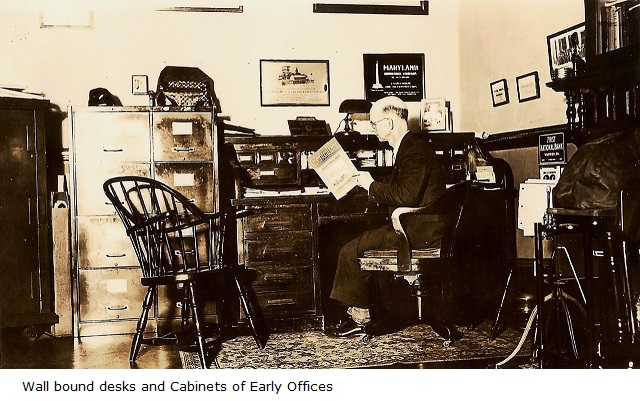
Early offices had, peripheral lay that is along the wall work tables and cabins. This gradually gave way to half height partitioned or ‘compartmental office spaces’. But today, according to the International Facility Management Association, 68% of North American employees work in offices with an open floor plan or open seating. Open offices are inefficient spaces, due to the larger per employee area, but less clustered.
Older employees and traditional businesses like, law, finance and other professionals, who have worked from cubicles, cabins and corner offices, find it difficult to adopt open offices. Open offices are blamed for affecting privacy, client relationships, employee productivity, loss of sense of belonging, and even compromising the morale.
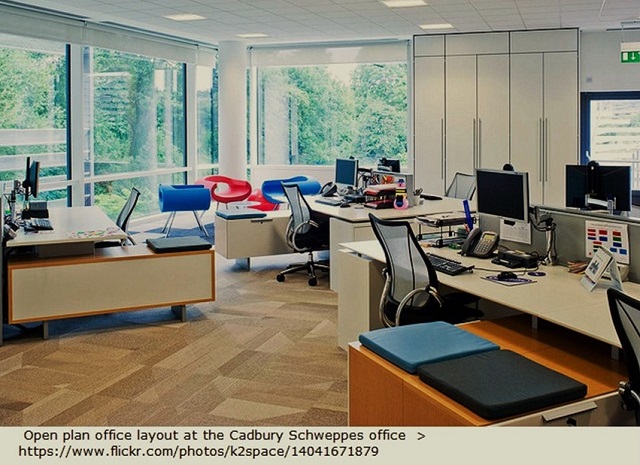
Open offices provided a visual cohesiveness and spatial continuity. Open office-plan also incorporated the concept of compact personal work module -like a work station. Computers also had work stations as dedicated utility for multi tasking. This concept was used by earlier craft’s people like watch repairers, engravers, gold smiths etc. to reduce the movement.
Offices during and immediately after world war-II period had as much 50 % of the total space devoted to storage. These were separated from work areas, and manned by store keepers. The store room volume and traffic to it were reduced with several technologies such as document facsimile systems, telecommunication, automated file access including the mechanical card-index sorting machines. Digital documents with computerization solved the problems of file storage, access and transfer. Now the offices were nearly fully ‘human occupied spaces’.
Wireless technology and cloud storage software make it easier for companies to embrace nomadic workstations, says Frank Rexach, a Shanghai-based vice president and general manager at Haworth. Rexach says ‘People don’t want to feel handcuffed to their desk, especially the Millennials’ (= young people who were between the ages of 10 and 20 on September 11, 2001 defined as per Newsweek Magazine).
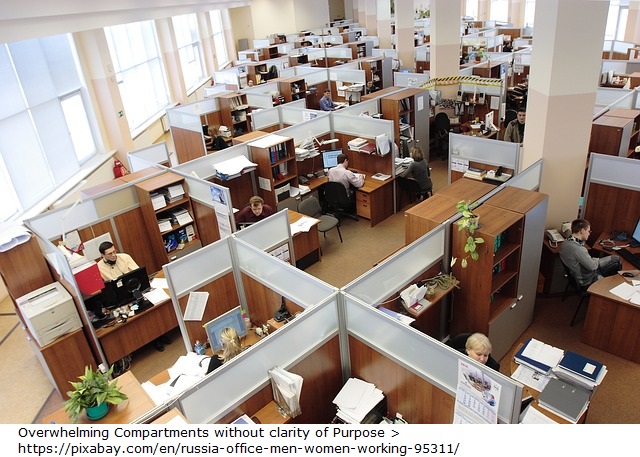
Laptops and tablet computers linked to remote servers reduced the location bound dependence. Wireless telecommunication, mobility and flexible work schedules allowed employees to work from location of their choice. The office space now remained a location for interactions. Of course this function too was met by video conferencing. Now the office space has become an unassigned seating place. The need to personally interact though has remained as acute, perhaps it emerged more strongly. The meeting rooms are common or rented facilities. Its interior space has high efficiency ambience but does not match the corporate aspirations of a ‘personal space’. In a different perspective, something similar is happening on educational campuses. The teacher-student relationship is missing on personal contacts. The lecture hall is partly replaced by seminar or workshop rooms.
Open office culture is moving a step ahead. Now the desk is no longer your personal den. You come, take a spot that is free, connect and you are in office. It takes away the culture of sharing a chat or knowing who is on and who is off. The familiar faces are in the meeting zone, which too keeps on changing depending on availability.

Just like open office plans, many other entities such as the partition less residences, self access retail outlets, libraries and kindergarten rooms have half or low height furniture elements. Glass curtain walled commercial buildings, etc. are also conceived to be boundless spaces. The boundless spaces are assumed to enhance the intra-personal interactions.
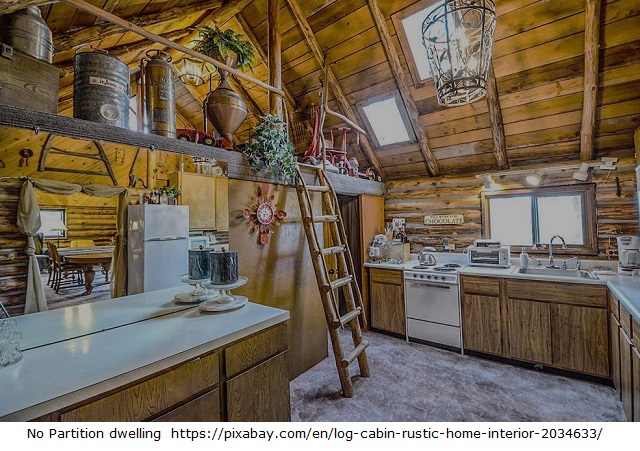
SPACE PLANNING BY PROFESSIONALS AND A LAY PERSON
Fresh architectural entities when sold or rented to a client have many ‘common or standard’ provisions which need to be improvised for specific uses. Space planning here is an adoptive exercise. Professional designers handle the project by developing a holistic strategy or an integrated approach. The space planning is very encompassing exercise requiring technical skills. Designers also have a selfish professional interest of impressing the client and the society at large with an invigorating solution.

A lay person may accept an initial standard design, and may not engage a professional for later day changes. A lay person, as a user, is continuously engaged with the space. Though the intervention, a very subjective one has greater insight. The user alters the arrangements as part of day to day living. There are a naturalness and continuity in the effort, because it is simplistic devoid of technicalities.
The lay person’s strategies include: 1st relies on spatial rearrangement and micro adjustments of entities in space. 2nd will buy ready-made items from the market, get it made, or craft them on own and 3rd the layperson exploits the enrichments for micro level space-making and adds a personal flavour to the space.
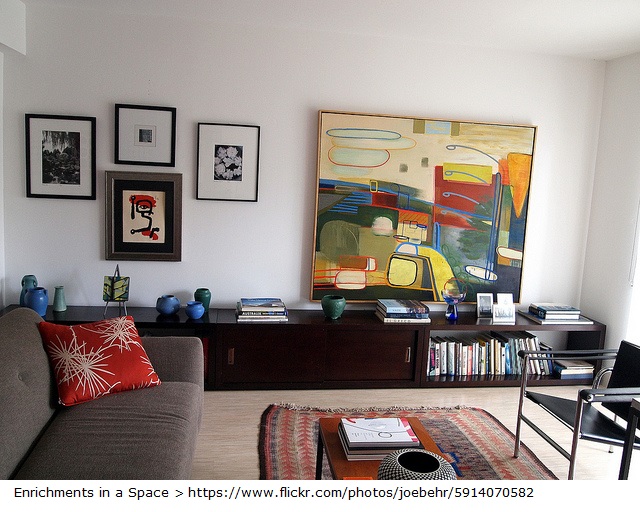
PERSONALIZATION OF SPACES THROUGH ENRICHMENTS
Enrichments are personal interventions to a space, by professional designers as well as lay users. These are extras over the nominal functional provisions of space planning. For professionals such endeavours are to support the thematic concept. These often lack the conviction for the actual owner-user. For lay persons enrichments evolve with the space over a longer period and after several trials. Enrichments are a subjective involvement of the user, reflected in the selection and placement of the enrichment. The selection follows traditions, taboos, customs, instincts, experience, perceptions, daring, suggestions and compulsions. The enrichments become a matured style of the locality or a group, an ethnicity of an era or a geographical identity.
Enrichments are selected for their own quality or appeal, and also as fitments to a given situation, but often without contemplating the desired end result. These are attempts to alter the scale and complexity of a space, by an element that is personal and perhaps familiar. Enrichments, as a result reduces the alienation and loneliness, and reduce the incidence undesirable or severity of abnormal behaviours.
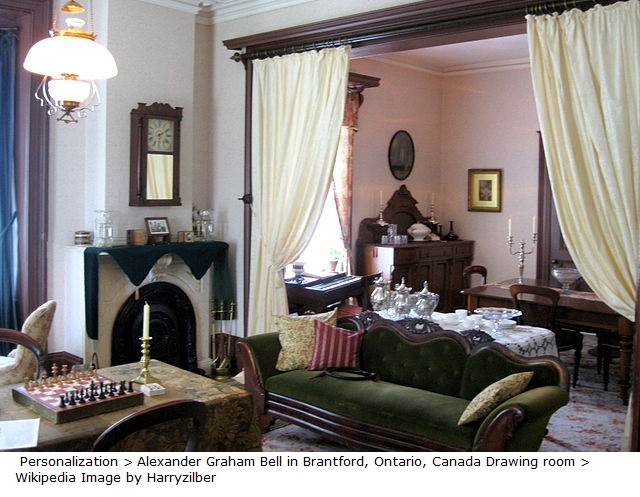
Personalization through enrichments occurs by many routes. The identification is achieved by cultural affinity, affirmation to a social cause (e.g. green spaces), confirmation to an ideology, expression of abstracted messages, display of authority, hierarchal structure, a diffusion, spiritual, history, continuity, desires for contrast or diversity, etc. Enrichments may not have a precise definition or explanation, but over a period attain an identity. Enrichments encourage the group dynamics with a sense of belonging. Enriched spaces have safety, security and assurance of performance.
Enrichments are:
- Objects that can be savoured from many sides. Vessels, utensils, statues.
- Surfaces like paintings, murals, wall pieces, posters, mirrors, glass, patterns, which denote floors, walls or ceilings or become partitions.
- Furniture to aid postures, task supports, storage entities, space intervening objects, furnishings like carpets, bolsters and curtains.
- Fittings and Fixtures that add to functionality of architectonic elements.
- Signage and Graphics to convey messages, indicate layout, symbols.
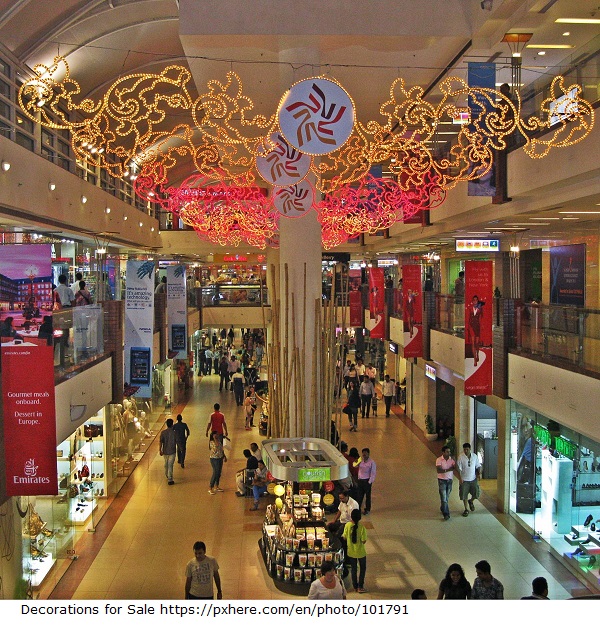
Enrichments are extensively used by retail outlets that rely on brand selling, and corporate entities who thrive on image making. Automobile showrooms flourish with superfluous space enrichments, because by the time some mature integration occurs, a new set of entities arrive. Compared to this corporate offices and hospitality spaces have well-integrated schemes. Other public spaces like museums, law courts, halls, etc. use enrichments very judiciously disguising as graphics or signage. Religious and political functions and processions use enrichments to show their large following.

SPACE PLANNING BY VISUAL and NON VISUAL MEANS
The personalization of a space achieved through visual means is very obvious as much as it is effective. Non visual sensorial effects are difficult to perceive, so difficult to express, communicate or record. These are equally effective, but are very subtle. Many of the visual means also provide non visual sensorial effects, at specific position and in certain circumstances. Professional designers, in their conventional space planning, give consideration to parameters like auditory, olfactory, tactile and atmospheric factors such as the temperature and moisture, etc. A lay person, however, finds it very difficult to replicate these in a personal space. The judgements on these counts are speculative because effective results derive from accumulation of several factors. A lay person considers non visual sensorial effects at best as the reinforcing elements to visual means. Other parameters such as the privacy, intimacy, well being, safety, security, seclusion and participation, are achieved through sensible space planning, but need space and time reinforcement through indicative means.

SPACE PLANNING and USE OF NON VISUAL SENSORIAL EFFECTS
Non visual sensorial effects are: mainly Auditory, Olfactory, Tactile and Gustatory.
- Auditory sense (relating to sound) provides the scale of distance, direction, and time. It indirectly reveals the quality of absorption and reflection.
- Tactile sense (relating to touch such as texture, temperature, moisture, electrical charge). It is a pervasive faculty, though some parts of the body are more sensitive. It is locative and part of the defensive mechanism.
- Olfactory sense (relating to smell or odours). It is closely related to quality of air and so instinct of survival is intimately linked. It is highly frontal and directional. It also gives the idea of distance.
- Gustatory sense (relating to taste buds) It is closely related to olfactory sense. It provides no sense of scale, distance or time unless with the Olfactory sense.
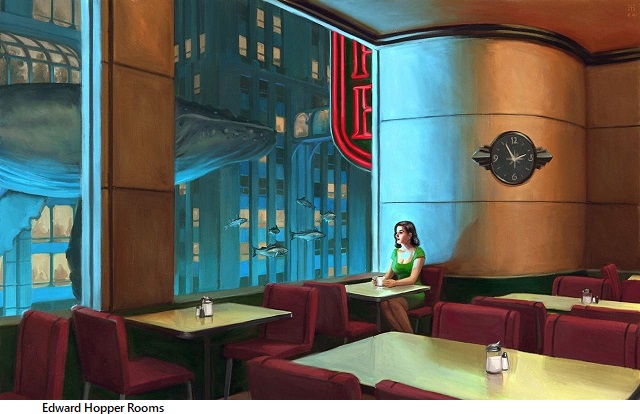
Visual and Auditory senses work in consonance, because both have a sense of scale and direction. In space planning one provides the clue about the other. The selection and placement of furniture, furnishings and enrichments can change the visual space perception, as much as the surface treatments of the same elements can change the audio quality. The purposes of space elements, their placement, composition, shape or size, are not very apparent to a casual visitor. However, such effects become apparent on the required occasion and situation. Tactile sense requires one to be in proximity of the surface, yet the textures, nature of construction (hollow, foamed, micro undulations), etc. prompt the auditory response from a distance, and so preempt the perception. Odours are perceived with air and its movements. Enclosed rooms filter the noise but reduce the chances of fresh air. This portends into ‘smelly’ or stagnant space. A designer has to perceive a space planning layout with all these overlapping sensorial effects, and also notions people have.

Noise: The size of work modules in open offices for the individual is decreasing due to factors like lesser personal volume of storage, smaller work area (instead of ledgers and files, it is laptop or notebook), and common facilities for interactions. There is a proportional increase in population density. The employees cannot stay focussed with greater noise levels, higher office population density and distractions from moving people, monitors and telephones. A mixed patterned space offers variety of spots, both uninterrupted and busy, private and collaborative, quite and participatory, to resolving the tension, loneliness, privacy, etc.
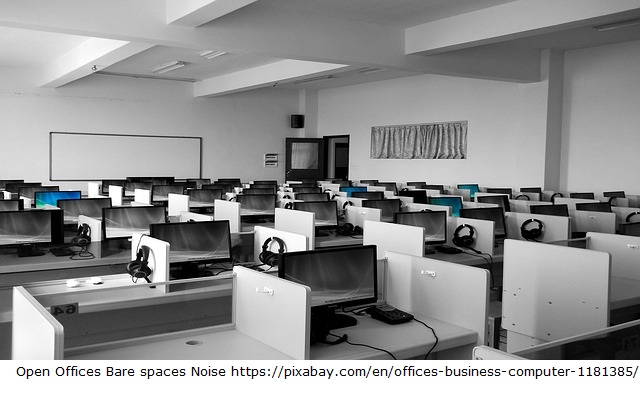
Sound masking is in contrast to the technique of active noise control through volume and pitch. It is addition of natural or artificial sound, such as ‘white noise or pink noise’ into an environment to cover up unwanted sound by using auditory means. It nullifies the awareness of pre-existing sounds. Open offices are either too quiet (such as past midnight, where someone dropping a pen in the next cubicle is distracting due to absence of background noise such as traffic), or too noisy (such as when the conversations of others in the office make it impossible to concentrate). Sound masking is adding of sound to cover the existing sounds in the area, to make workers less distracted and more productive. Private offices and study rooms are not sound proof as sound can travel out through partitions or over the walls Sound masking can be provided in adjacent private offices, or in hallways outside of private offices, to ensure that confidential conversations remain confidential. Public spaces are used to reduce the continuous disturbance from road or railway traffic in covered walkways, under passes, deep and extensive parking areas, etc.

Environmental parameters: HVAC and other experts take care of these aspects of atmospheric comforts in space planning. The air movement in large spaces have few problems, for example, in humid climates. Very high air movements disturbed the papers and ruffle the hair. Yet there always are few pockets with poor air circulation. Such pockets are more prominent in open office plans which are partly compartmentalized. Open office-plan can be well sustained with a machine aided cooling or heating systems. The floor touching partitions of open office cubicles and comparatively low ceilings hinder air circulation. It creates areas with poor air change, uneven cooling-heating, poor moisture control, inadequate dilution of air bourne pollutants and odours. Presence of mosquitoes in the lower sections of cubicles due to stagnancy of air is a great health hazard.
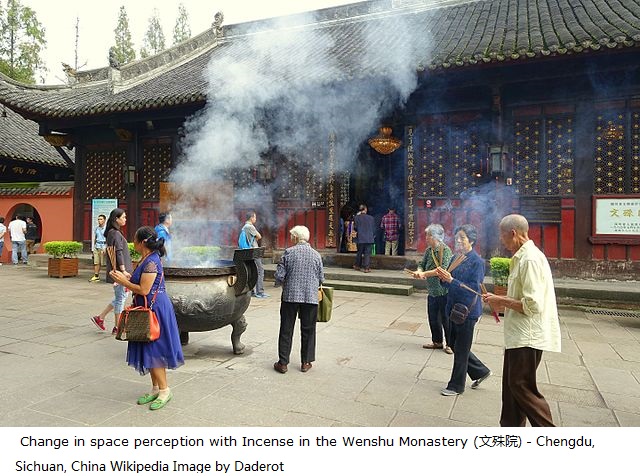
Odour control: Odours occur and persist in commercial spaces. Odours are generated by materials, processes and human occupation. Confined spaces such as underground car parks or basements, garbage areas, passages, etc. have poor air-change. Offices where coffee, snack and meals are allowed in work zones have greater degree of air fouling. The odour can be controlled through basic three methods: Greater dilution with fresh air, Finer scrubbing of odours, and Larger exposure to natural sun-light UV rays. Odours from surface finishes, cleaning compounds, treatments applied on furnishings and degeneration of plastics, etc. are controlled best by proper selection rather then any processes. Human skin scales, biologically degenerate very fast, and it is a major problem for spaces with large human traffic. Here again, regular vacuum cleaning is the best method, but for this smooth and hard floors, in place of fiber or synthetic carpets are required. Odours of slightest measure are detected and detested by first time visitors. However, masking an odour with deodorant is only delaying and compounding the effects of odours.
For good ventilation, dilution or adding fresh air, is the best technology. Next method is to use various types of non chemical techniques of scrubbing the air (ion charging, micro filtering, etc.). Ventilation system adjusts the temperature, replenishes proportion of oxygen, removal or addition of moisture, diluting or scrubbing the air to remove odours, smoke, dust and airborne bacteria.
SPACE PLANNING AND BEHAVIOUR
Space planning determines the placement of various items of furniture. The placement decisions follow two important strategies:
- Functional positioning and circulation integrating various architectural features.
- Provisioning for personal spaces and for Inter-personal relationships or group dynamics.
It is this later aspect that can destroy all the good intentions of the former. Space planning and behaviour as political etiquette is a time-tested mannerism formalized in government protocol manuals. It shows how two equal or unequal status heads of state or such entourages must meet. It indicates the nature of seats, intervening pieces of furniture, the backdrop for the meet, and enrichments that are appropriate, and ones that must be avoided.
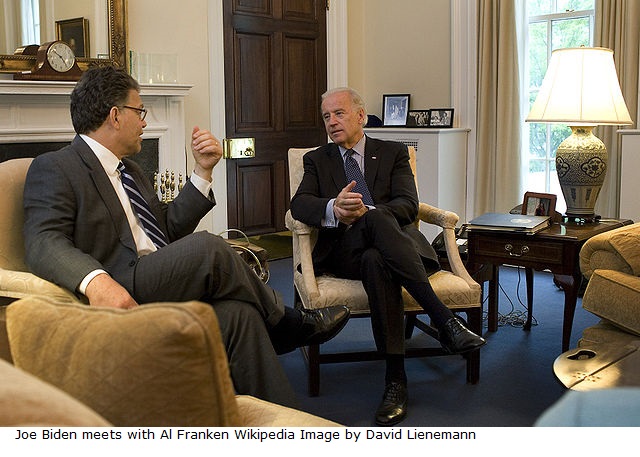
The chairs for personal meeting of two important (equal status) personalities (e.g. Presidents of two nations) are upright single seat units (placed parallel but very slightly askew @140°). But we still find dignitaries taking on micro postures by moving towards or leaning on one hand-rest, sitting cross way (diagonally), leaning forward or backward. The reasons are: one is trying to enlarge or reduce the distance, take postures that imply affability, propriety, esteem, etc. However, the sitting arrangement between two unequals, like a president and a prime minister (or a prime minister and a foreign minister) have two unequal (size, form, style) types of seats. The person with higher status sits in a single seat unit, whereas the other party is made to sit at a right angle, and on a wider seat (double or triple seat sofa or even stiffer – upright seat). The furniture arrangement, the angle and the distance between them are regulated by set of rules or ‘protocol’. In spite of the strict protocols people through micro posturing do subconsciously express their real attitude. The body language is just one facet of behaviour that reveals the nature of the encounter.
At domestic level traditions and taboos are followed for placing the items of furniture. Commercial spaces and hospitality spaces reflect a mix of local mentality, good practices, and new trends elsewhere. Traditions emerge after years of usage and portray the geographical, historical, cultural, religious and technological preferences. The trends show universal preferences emerging from cross reactions of many art forms. The furniture and its placement offer several postural and interaction possibilities, affecting the personal relationship as well as group behaviour dynamics.
Living rooms of economic housing schemes are 3000-4000 mm wide. The eye contact or person to person distance for such sofas across the room is 2400-3400 mm, just adequate for social or non intimate chat. However, for a living room width of 5000 mm, the interaction distance becomes (for sofa across the room) 4400 mm. This is not conducive to social interaction, unless one can makes own-self herd by talking loudly, or seating forward -at the edge of the sofa. In large rooms chatting is more common with persons sitting on the side seat.
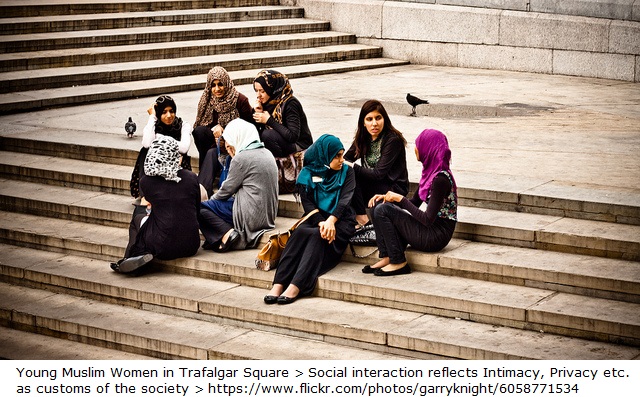
INTIMACY AND PRIVACY
These are important aspects of space planning in hospitality spaces and personal cabins. Visitors need these in appropriate mix, but staff also needs to maintain a non intimate posture and distance.
In such places receptionists are always in standing position -as if ready to serve. The backdrop is are nearly 1500-2000mm away -meaning they are on their own, confident, and cannot depend on back support. Coffee house and pub tables are small, so that people sitting across maintain intimate distance of 600 mm or less. Banquet tables are 1200 mm to allow talking across the table, but a wider table 1500 mm or more discourages the personal interactions and makes the occasion more formal. Important personalities use office tables of 900 mm or more depth to create a person to person (face to face or eye contact) distance of 1600 mm, which makes the interaction formal and non-committal.
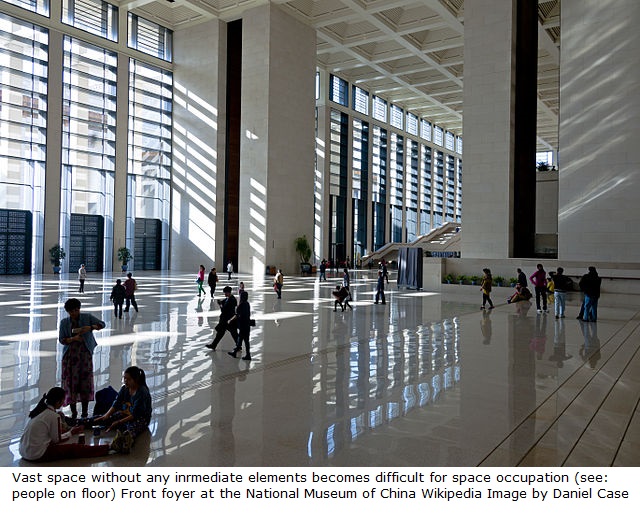
RECOGNITION
Recognition of personal attributes in a space planning layout automatically resolves many issues of intra-personal relationships. Every individual needs to play a role, whether it is a small domestic or a public space, but in a required setting. The set is made of architectonic elements, space occupying entities and environmental conditions. Recognition is also important for expression and communication. The deficiencies of personality are made up by the surroundings. Some of the tricks, people consciously or otherwise use to draw recognition are: Standing against a wall but little away from it, occupying a single seat rather then share one, positioning against a bland-background then a clustered or busy face, sitting in a tall, upright and an uncomfortable chair opposed to an easy and low height seat.
SECURITY
A person feels secure if protected from at least one side, and can control the distance for group behaviour dynamics. A person must get the benefit of natural attributes of the personality such as age, sex and social stature. A person may not feel confident and so secure if under a continuous gaze or surveillance. Feeling of security is more enhanced in known spaces or spaces with a familiar set-up. Large spaces with adequate points of anchors or interventions make a person feel secure. People feel secure with exits points like a door, stairs, passages, aisles near them. A view of outside from an opening adds to security. Presence of handling, holding or barricading devices adds to security, even if one may not intention or need for using it.
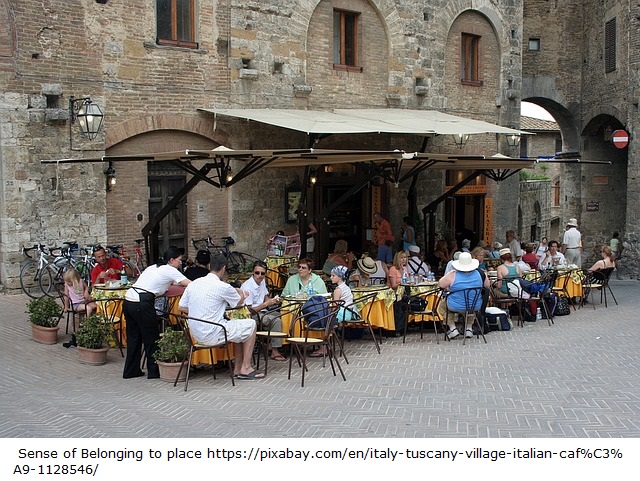
OWNERSHIP OR SENSE OF BELONGING
The control mainly derives from the right to conceive, execute, alter, explore and exploit a space. For this one may not legally own or be a tenant of the space. Members of a family or a group get a sense of belonging. People with same ethnicity or cultural orientation feel ‘at-home’ in spaces that have a familiar set-up. Spaces with standard internal features provide the equality. Similarly a sense of belonging may occur where external configurations are similar, as in public housing schemes.
This is the FOURTEENTH lecture in the series Space and Human Behaviour for Winter semester, 2017, at Faculty of Design, CEPT University, Ahmedabad, India.
.
One thought on “14 – SPACE PLANNING and HUMAN BEHAVIOUR”